Mito Red Light makes high-quality yet affordable red light therapy devices, including the MitoPRO 300 and 1500 (which I’ve been using to improve my sleep, skin health and muscle recovery) and the Mito Advanced Red Light Therapy Belt (which my wife has been using to improve the appearance of pregnancy-induced stretch marks on her abdomen).
In this article, I’ll review Mito Red Light’s devices based on our hands-on experience and explain why we’ve been recommending them to friends and family.
Mito Red Light

Summary
Mito Red Light makes affordable red light therapy devices that emit a combination of red and near-infrared light using the most bioactive wavelengths to help improve sleep, skin health, muscle recovery and fat loss.
A Brief Overview of Red Light Therapy Benefits
Before we get into the details of the various Mito Red Light therapy products, let me give you a brief overview of the health benefits associated with red light therapy in general.
- Improves skin health, including increased collagen production and the reduction of wrinkles and fine lines. Additionally, red light therapy has been used in the medical field to speed up wound healing and to help treat inflammatory skin conditions such as acne.
- Reduces inflammation and pain by improving blood circulation, blocking pain signals from reaching the brain, and releasing hormones (like serotonin and β-endorphin) that make you feel better.
- Speeds up muscle recovery by increasing oxygenated blood flow to the target tissue.
- Improves sleep by increasing melatonin levels and helping reduce sleep inertia.
- Helps with weight loss by triggering fat cells to release triglycerides, which your body can then use for energy (when combined with exercise).
- Promotes hair growth by supporting hair follicle proliferation.
To learn more about the mechanisms and the scientific evidence behind these outcomes, make sure to read my full article on the health benefits of red light therapy.
Why We Utilize Red Light Therapy
While my wife is interested in red light therapy for predominantly cosmetic reasons (e.g., fat loss and fine line reduction), I added red light therapy to my wellness routine to help improve my sleep, speed up muscle recovery after intense CrossFit workouts, and make my skin more resilient to sunlight (which can indirectly also improve my vitamin D production).
However, considering that I’m over 40, I also welcome some of the cosmetic benefits of red light therapy, including increased collagen production in the skin, which can reduce the visible signs of aging (e.g., fine lines and wrinkles).
Mito Red Light Review

Mito offers a variety of red light therapy devices, including three different series of red light panels and portable devices, as well as a red light belt. In this review, I’ll give you a side-by-side comparison of the various products and help you decide which red light panel might be the right choice for you (based on your health goals).
I should also mention that Mito Red Light offers a commercial product lineup that I won’t cover as part of this review.
| Mito Red Original | MitoPRO | MitoADAPT | Mito Mobile (FLEX) | Belt | |
|---|---|---|---|---|---|
| Emits red + NIR | ☑️ | ☑️ | ☑️ | ☑️ | ☑️ |
| Wavelengths | 660 nm, 850 nm | 630 nm, 660 nm, 810 nm, 850 nm | 630 nm, 660 nm, 810 nm, 850 nm | 660 nm, 850 nm | 660 nm, 850 nm |
| Number of modes | 3 | 3 | 11 | 1 (3) | 3 |
| Modular and stackable | ✘ | ☑️ | ☑️ | ✘ | ✘ |
| Irradiance | 115-165 mW/cm2 | 130-170 mW/cm2 | 106 – 130 mW/cm2 | 100 mW/cm2 | N/A |
| Portable | ✘ | ✘ | ✘ | ☑️ | ☑️ |
| Mobile app | ✘ | ✘ | ☑️ | ✘ | ✘ |
| Warranty | 2 years | 3 years | 3 years | 1 year | 1 year |
| Starting Price | $249 | $349 | $549 | $199 ($249) | $329 |
As you can see in the table above, Mito Red Light offers different products to accommodate a wide range of budgets and requirements.
If you’re interested in purchasing any of the Mito Red Light products, make sure to use the links in this article to get a 5% discount (which is automatically applied to your cart at checkout).
Before getting into the technical differences between these red light therapy devices, let’s separate them into two categories, including stationary panels (meant to be used with a stand or mounted on a wall or door) and portable devices (which are ideal when you’re on the go).
As far as stationary red light panels are concerned, Mito Red Light offers three different panel series, including:
- Mito Red Original 2.0: Offers the best bang for your buck if you’re on a budget.
- MitoPRO (I have two of these): Offers four of the most bioactive wavelengths, and the modular panel design allows you to stack up to four panels for increased coverage.
- MitoADAPT: Offers 11 different modes that allow you to customize the exact wavelengths and light ratios you want to use. Plus, you can control the panel using a mobile app.
On the portable side of the portfolio, Mito Red Light offers the following products:
- Mito Mobile: A small yet powerful red light therapy device for on the go.
- Mito Mobile FLEX: A slightly narrower version of the Mito Mobile that allows you to use all 12 LEDs as NIR, red light, or a 50/50 combination of the two.
- Advanced Red Light Therapy Belt: The most convenient red light therapy device for treating your abdomen, lower back or quads if you’re on the go.
Let’s talk about the pros and cons of each of these products to help you decide which one is right for you.
Note that the price ranges mentioned below refer to the different panel sizes Mito Red Light offers within a series. Depending on the series, the company usually offers between three to four different panel sizes ranging from small (tabletop) to large (wall-mounted) panels.
MitoRED Original 2.0

Pros
- Affordable.
- Wall and door mountable.
- Two-year warranty.
Cons
- Supports only 660 nm and 850 nm wavelengths.
- No mobile app.
Priced between $249 (MitoMIN 2.0) and $1,049 (MitoMEGA), the original series is an excellent choice if you’re on a budget but are looking for a high-quality red light therapy panel that offers a combination of red and near-infrared light (660 nm and 850 nm) with excellent irradiance, low EMF emissions and a two-year warranty.
What you don’t get with the MitoRED Original is the additional wavelengths (630 nm and 830 nm) and the flexible mounting and stacking options the more expensive panels offer. In other words, you lose some benefits and flexibility without sacrificing quality.
I’d specifically recommend the original series if you’re on a budget and want to use red light to treat certain areas of your body (such as your face) and don’t plan on doing full-body treatments in the future (which would require you to stack panels).
MitoPRO

Pros
- Broad wavelength support (630 nm, 660 nm, 830 nm, 850 nm).
- Compatible with various floor stands.
- Module design (can be stacked for increased coverage).
- Three-year warranty.
Cons
- No mobile app.
- Limited wavelength control.
If you’re planning on combining or stacking several panels to increase their coverage, the MitoPRO series might be the right choice for you.
Priced between $349 (MitoPRO 300) and $1,149 (MitoPRO 1500), this series supports four of the most bioactive wavelengths (630 nm, 660 nm, 830 nm, 850 nm) for maximum benefits. Additionally, you can stack up to four panels and mount them on different types of stands for maximum coverage and flexibility.


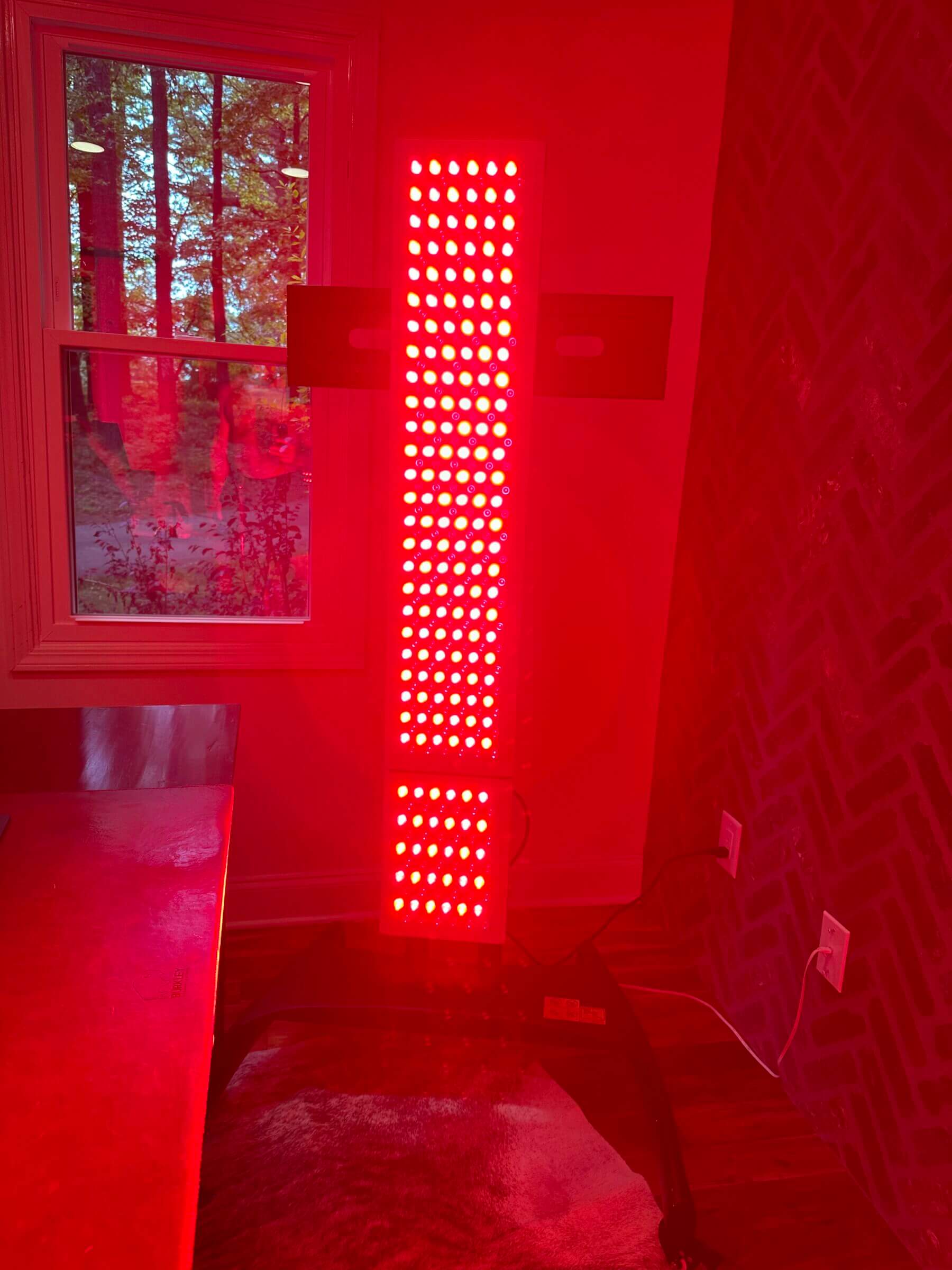
I currently own the MitoPRO 300 and MitoPRO 1500 (the company’s largest single panel), which can cover about 42 inches of my body.
In other words, I can treat the area from my thighs to my face.
I’ve been using the MitoPRO 1500 in both a standing and sitting position to treat various areas of my body, including my face. However, if you’re mostly interested in facial treatments, I’d recommend going with the much smaller (and less expensive) MitoPRO 300 panel, which comes with a tabletop stand.

I’ve linked both my MitoPRO panels together using the included cables so I can control both panels using the controls of the master panel (in my case, that’s the MitoPRO 1500).
Occasionally, I use the MitoPRO 300 by itself for facial treatments in the morning.
MitoADAPT

Pros
- 11 modes to fully customize your treatment protocol.
- Mobile app with Bluetooth support.
- Broad wavelength support (630 nm, 660 nm, 830 nm, 850 nm).
Cons
- Lower irradiance than MitoPRO.
- Price.
Mito Red Light launched the MitoADAPT in late 2022 with the goal of offering customers even greater flexibility when it comes to selecting different wavelengths based on the desired health benefits.
To that end, MitoADAPT offers 11 different modes that let you fine-tune the amount of light the panel emits in each supported frequency, allowing you to pick and choose the wavelengths you want to use (and at what ratio) depending on the health benefits you want to achieve.
For example, if you want to focus on improving your skin health, you could turn off the near infrared wavelengths (830 nm and 850 nm) and instead operate the panel with 100% red light (630 nm and 660 nm). On the flip side, if your goal is to reach your muscle tissue for pain relief and increased ATP production in the mitochondria, near-infrared radiation is likely more beneficial.
Additionally, the MitoADAPT has a built-in Bluetooth radio that enables you to control the panel using the Mito Red Light mobile app.
Of course, the MitoADAPT features the same modular design as the MitoPRO, enabling you to stack panels for increased coverage.
I think the MitoADAPT is an excellent choice if you have use cases that would benefit from being able to select specific wavelengths.
Anecdotally, however, it’s worth mentioning that while the Sunlighten mPulse full-spectrum infrared sauna we have at home also features customizable treatment protocols using specific wavelengths, we rarely bother with selecting a specific protocol.
Mito Mobile
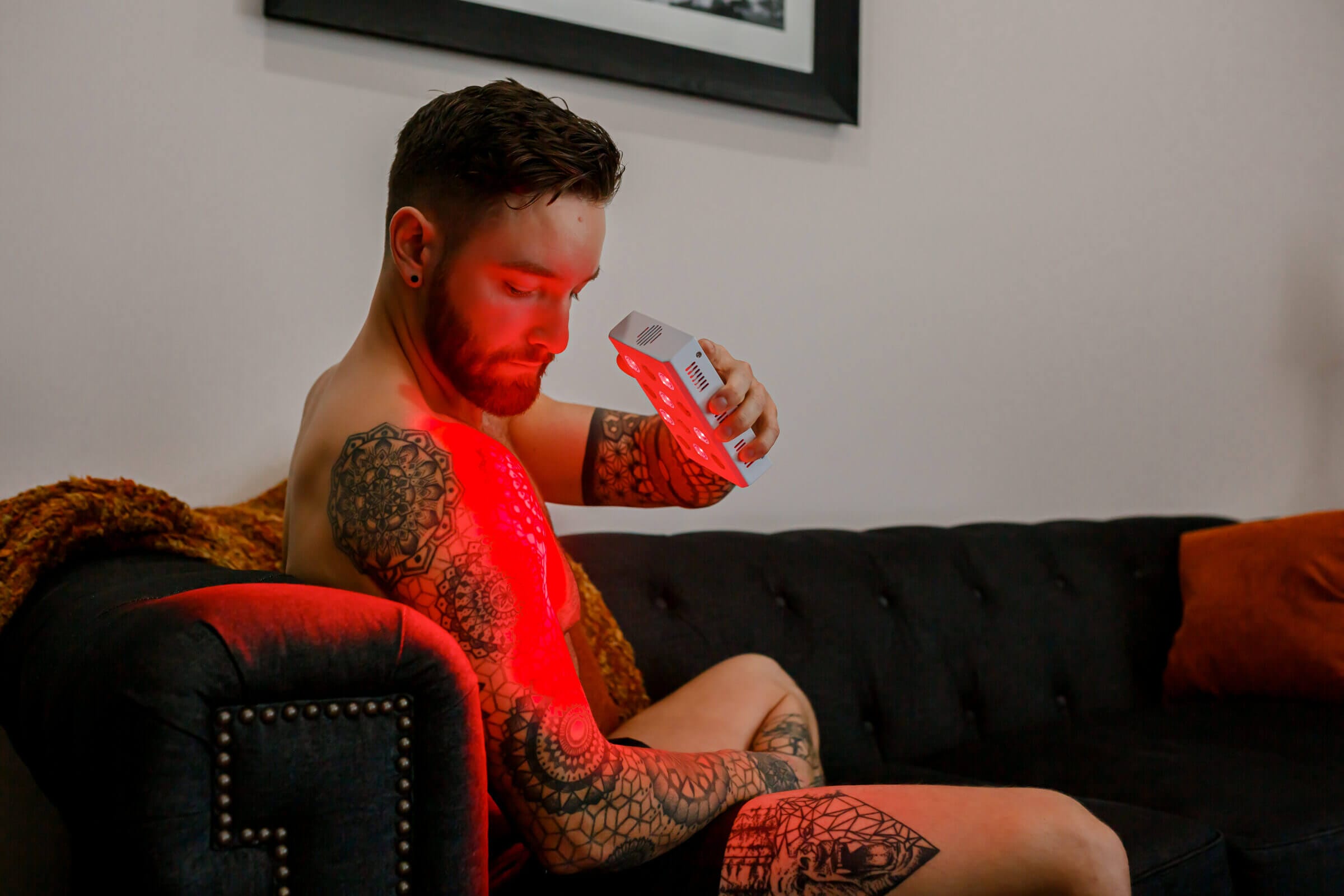
Pros
- Excellent portability.
- Great value.
- Combines red and NIR light.
- Battery has a lifespan of 5,000 hours.
Cons
- Offers only a single mode (50/50 red/NIR light).
- Panel is slightly thicker than the Mito Mobile FLEX.
Weighing only 1.3 pounds, the Mito Mobile offers a convenient way to stick with your red light therapy regimen when you’re traveling. The 12 built-in LEDs deliver an even combination of red and near-infrared light, and the 10,000 mA battery delivers up to three hours of use.
The downside of this ultra-portable red light therapy device is that it offers only a single mode, with the 12 LEDs delivering an even split of 50% red and 50% near-infrared light in 660 nm and 850 nm wavelengths.
Personally, I don’t think that’s a big deal because that’s the mode I’d be using most of the time anyway.
It’s also worth noting that the internal battery has a maximum lifespan of approximately 5,000 hours. So, even if you use Mito Red Light every day for an hour, the battery will likely outlast the rest of the device’s components.
Mito Mobile FLEX

Pros
- Includes all the features of Mito Mobile.
- Improved portability.
- Configurable light output.
- Comes with additional accessories.
Cons
- None.
The Mito Mobile FLEX is a slightly more advanced version of its less-expensive sibling, the Mito Mobile.
The FLEX packs 12 dual-chip LEDs that enable you to use only red, only NIR, or a combination of red and NIR light. Additionally, the FLEX is about one inch narrower, which makes it easier to hold in one hand — a good reason to opt for the FLEX if you have smaller hands (like my wife does).
Moreover, the FLEX comes with a couple of useful accessories, including a tabletop stand and glasses to protect your eyes during facial treatments.
Battery life and lifespan — as well as the one-year warranty — are the same as the slightly thicker Mito Mobile panel.
Advanced Red Light Therapy Belt
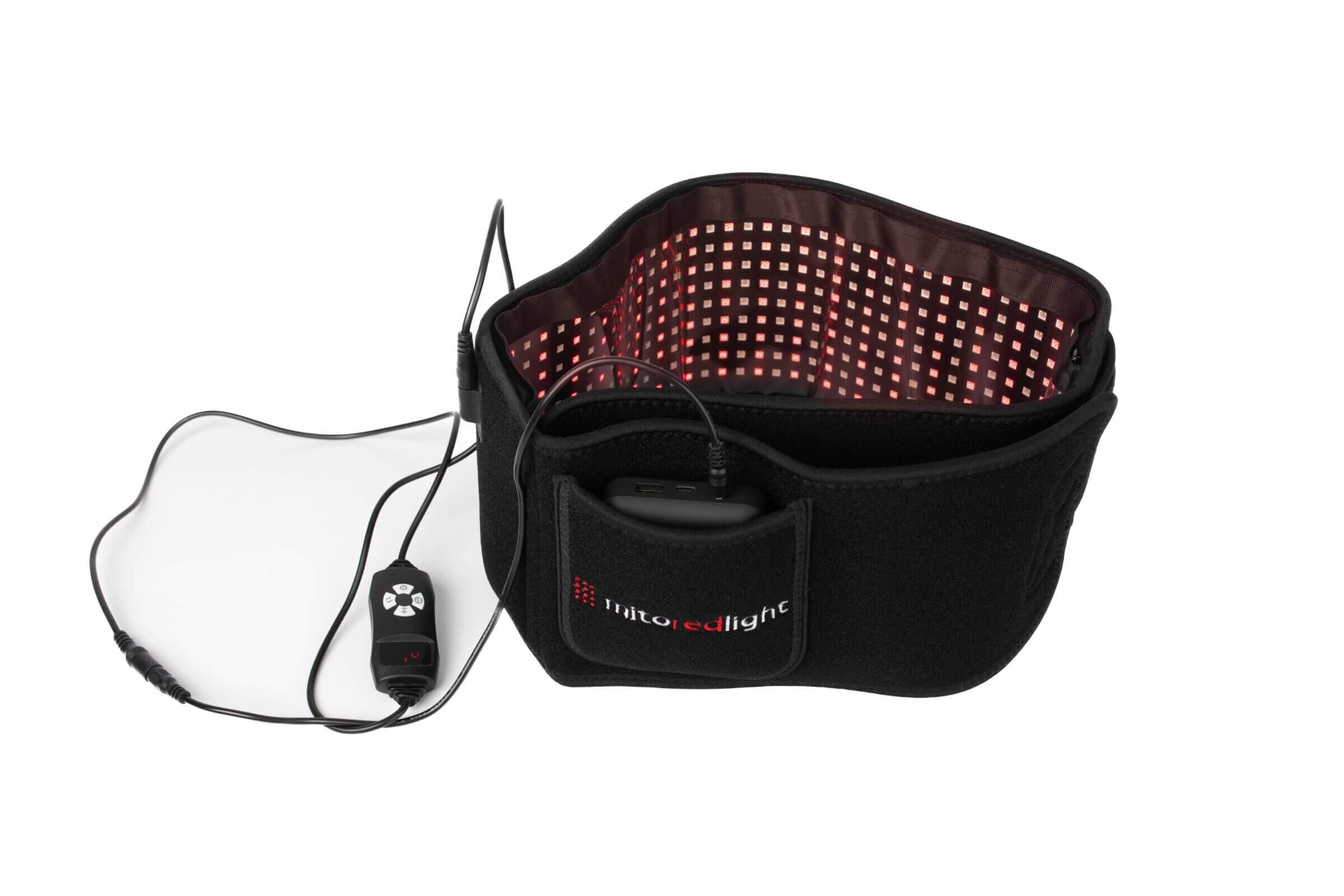
Pros
- Ultimate hands-free portability.
- Excellent for treating isolated areas of the body.
- Configurable light output.
- Great battery life.
Cons
- Has to be cleaned periodically.
The Advanced Red Light Therapy Belt offers the ultimate in convenience and portability because you can wear it like a belt (as the name implies). That makes it easy to treat specific areas of your body, including your abdomen, lower back or thighs (including your quadriceps).
What’s also cool about the belt is that it comes with a detachable and rechargeable battery pack that lasts anywhere from two to six hours, depending on the chosen light intensity level.
From a technological perspective, the belt includes 405 triple-chip LEDs that deliver a combination of red and near-infrared light using 660 nm and 850 nm wavelengths. Using the wired remote control, you can select if you want to use only red, only NIR, or a combination of both light types.
My Hands-On Experience With Mito Red Light
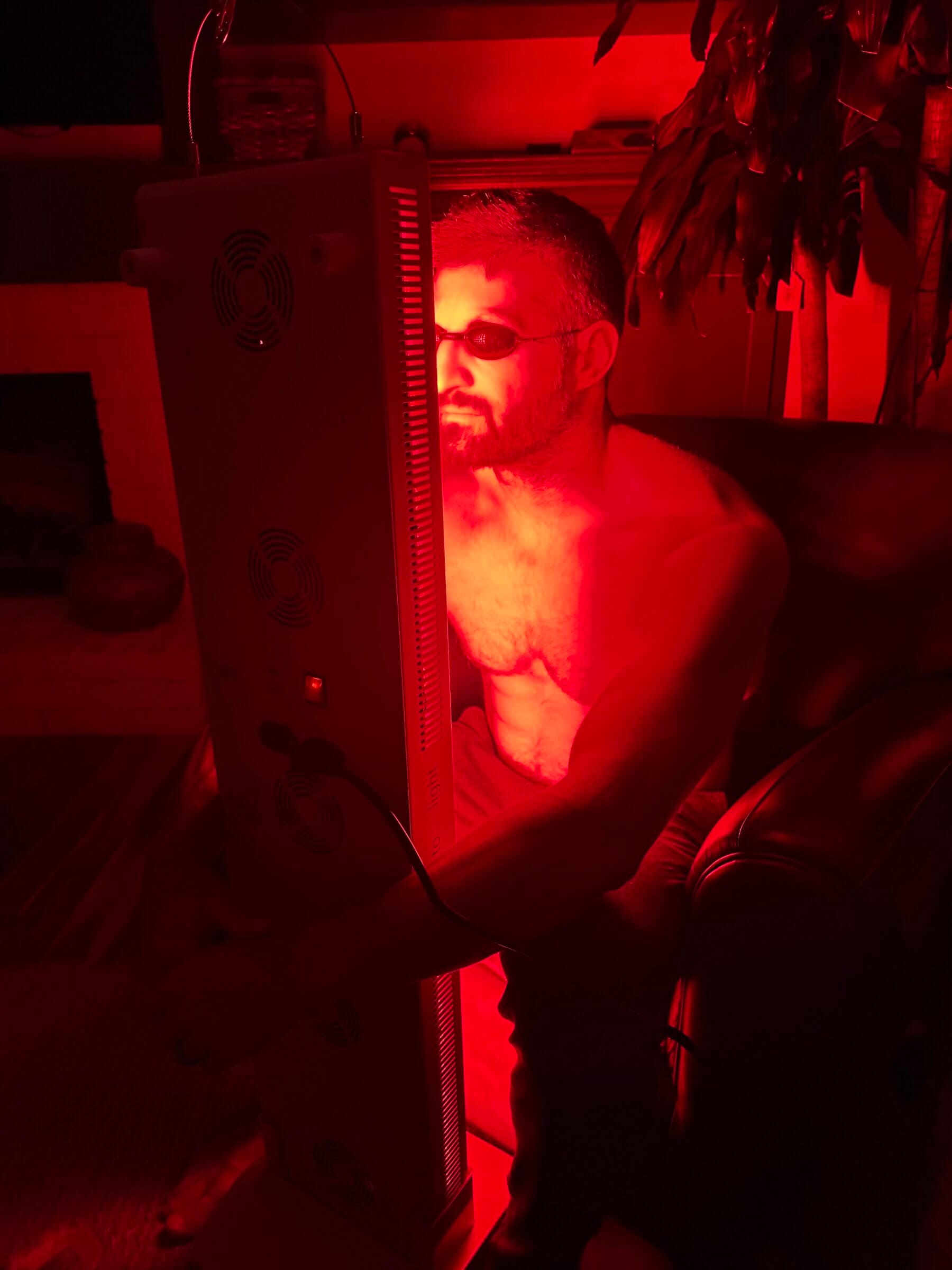
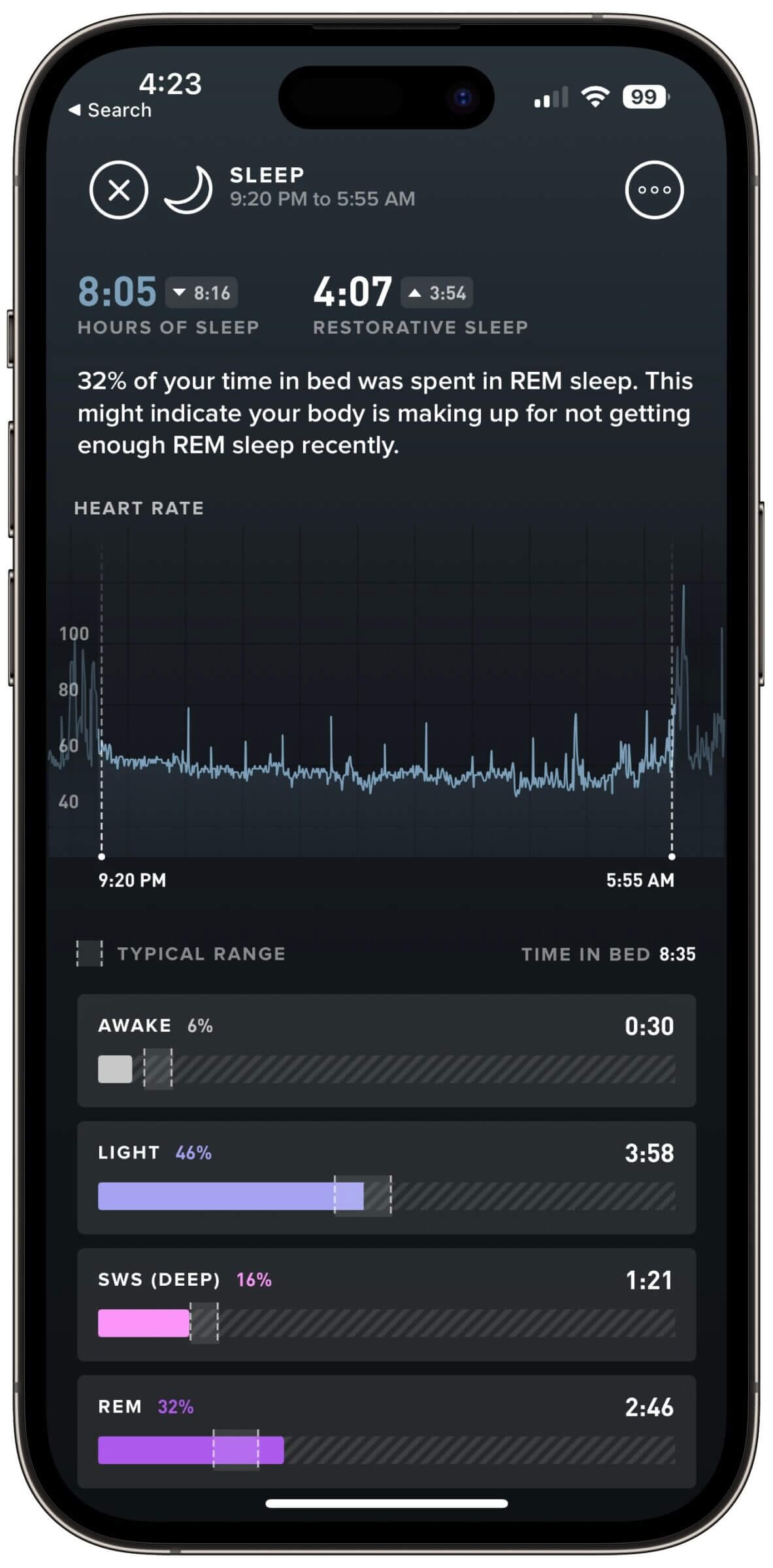
As I mentioned in the introduction, I’ve been using the MitoPRO panels several times a week to help improve my sleep (by increasing melatonin levels), make my skin more resilient, improve collagen production and speed up muscle recovery.
To improve sleep, I expose my face and naked upper body to red light several times per week in the evening. Of course, I wear the included safety goggles to protect my eyes from overexposure.
Within a few days, I started noticing increased sleep pressure in the evening, allowing me to fall asleep quicker. I also noticed that my WHOOP Strap (which I use to track sleep and other biometric data) was showing increased time in the restorative (deep and REM) phases of sleep.

For muscle recovery and to improve skin health, I treat my back or the side of my body almost every morning while sitting in front of my computer. Considering that it’s late autumn as I write this, I’ll have to wait until next summer to tell whether red light therapy has helped my skin be more resistant to UV light and if I produce more vitamin D as a result. I’ll make sure to update this review once I have collected more data.
What’s convenient about the MitoPRO 1500 is that it’s tall enough to cover two-thirds of my body. So depending on whether I sit or stand, I can treat most of my body in a single session.
I also like the flexible mounting options the MitoPRO series offers. For example, when I first got the panel, I had it hung on the inside of my office door and would use a stool to treat my back every morning before I began working. The only problem with hanging the red light panel on my office door was that the door would no longer close, because of how tight the door fits into its frame. Our bedroom door doesn’t have that issue, but there’s no outlet near that one.
After a few days, I switched to using the optional floor stand that’s equipped with four wheels, making it easy to move the panel to wherever I want it. So now I can just pull the panel up next to my chair and continue working on my computer.
I also own the slightly bulkier vertical stand (which the company has since replaced with a universal stand that works both in vertical and horizontal configurations), but I didn’t unwrap that until I got a second panel (the MitoPRO 300 a few weeks ago).
Using the larger stand Mito offers has the advantage that you can stack up to four panels. I only have two panels, but I like that the horizontal stand is height-adjustable. The only issue with stacking the largest and smallest panel Mito sells is that the smaller panel isn’t attached to the stand using a bracket. Instead, it hangs from the bottom of the larger panel using a pin. The problem with that connection is that the pins can slide when you move the panel, causing the smaller panel to crash on the floor and get damaged.

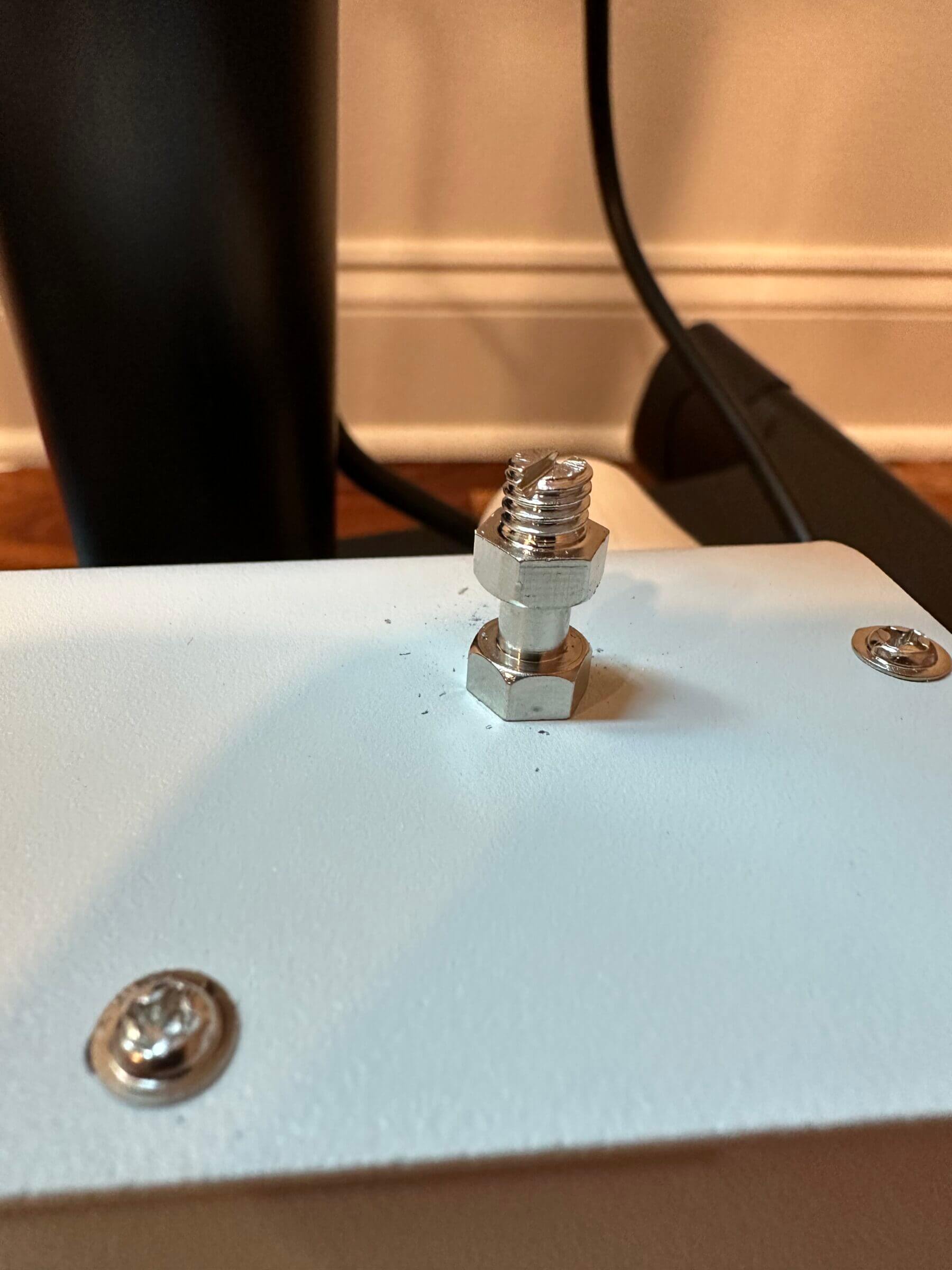
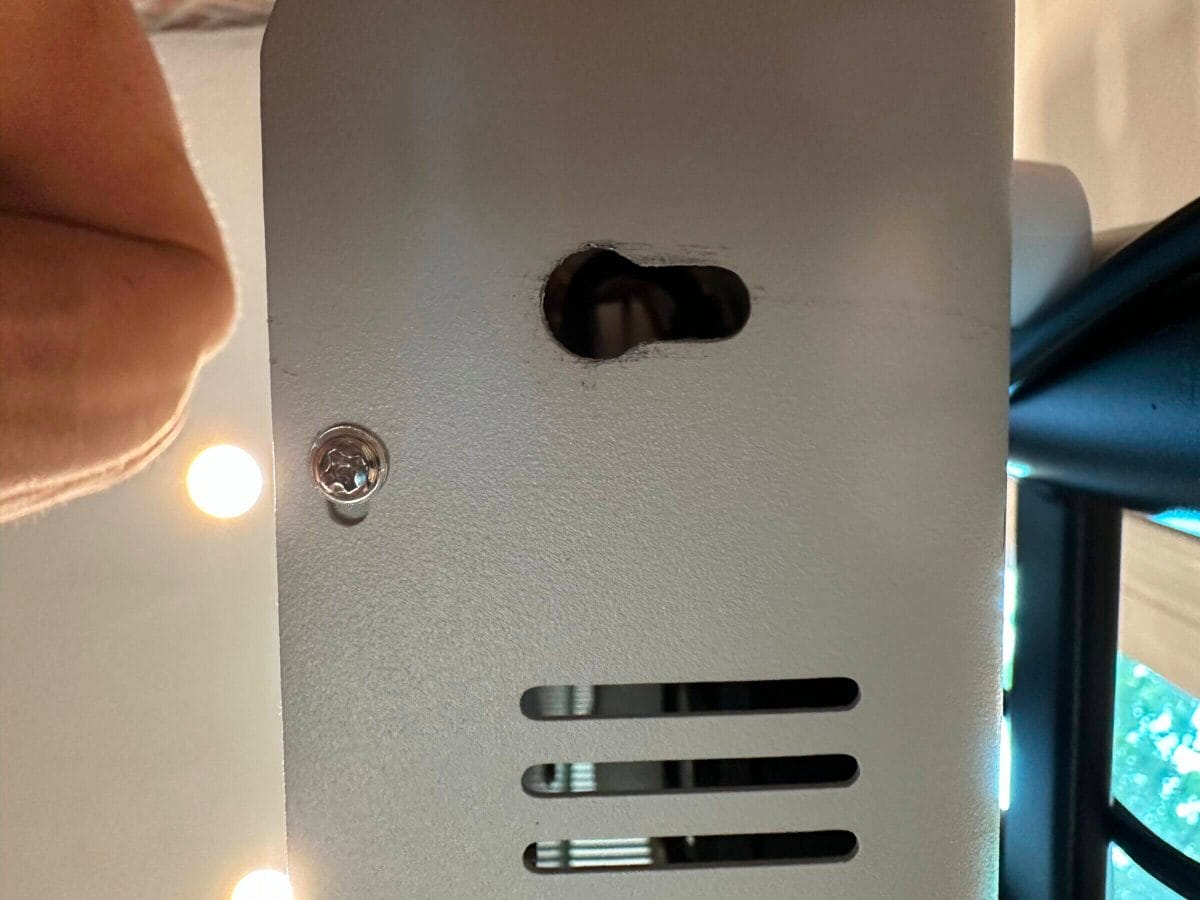
I mitigated that issue by stuffing a piece of foam between the two panels, which creates tension by pushing them apart. That way, the pins can’t slide and come out.
For what it’s worth, the medium-sized MitoPRO 750 can be attached using brackets, so you won’t face this issue if you decide to stack it with a larger panel.
Based on what I’ve seen online, the issue described above only applies to the older horizontal stand, which Mito no longer sells
Overall, I appreciate the build quality of the Mito Red Light panels. They seem incredibly well built and easy to use and operate.
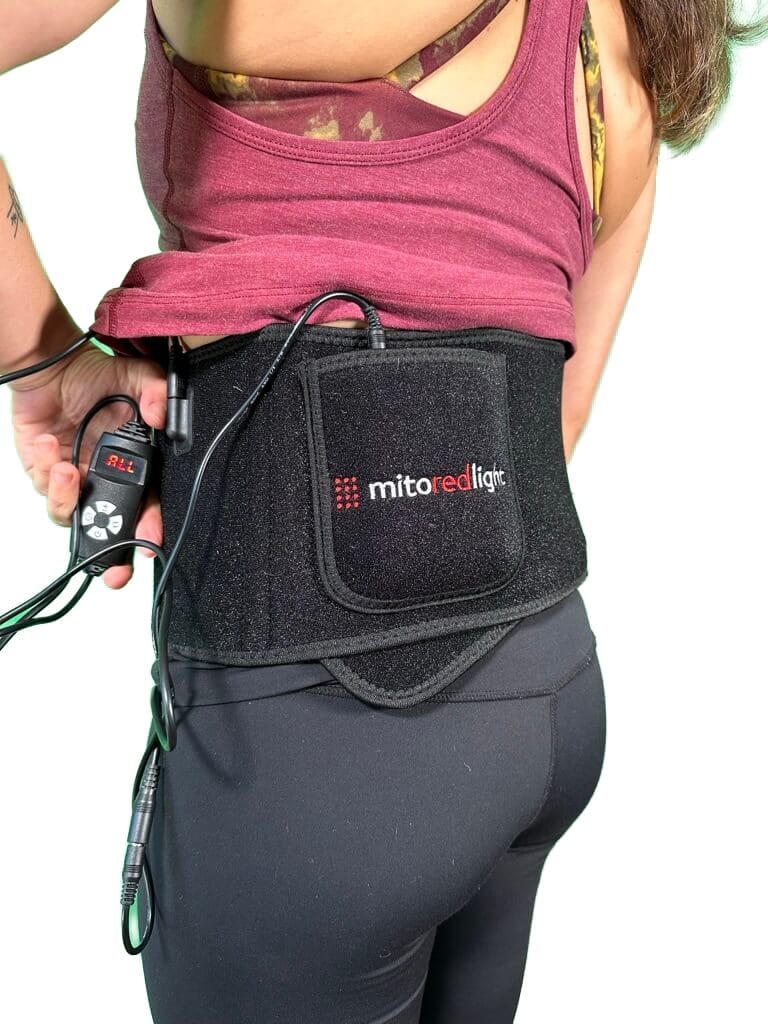
In addition to the MitoPRO 1500, my wife started using the Mito Red Light Advanced Red Light Therapy Belt a few weeks ago to help flush triglycerides out of fat cells before working out and to increase collagen production in the skin on her abdomen, which is covered in stretch marks.
As I discussed in my article covering the benefits of red light therapy, flushing triglycerides out of fat cells can help you burn fat if you push your body into using those released fat molecules for energy. The best way to do so is by consuming a low carbohydrate diet combined with exercise following a red light therapy treatment.
The degree to which the Mito Red Light Advanced Red Light Therapy Belt will help my wife shed stubborn belly fat and improve her stretch marks remains to be seen. However, considering the success my wife has seen with using red light therapy to improve the appearance of her skin on other areas of her body, I’m confident we’ll see positive results.
Mito Red Light vs. Alternative Products
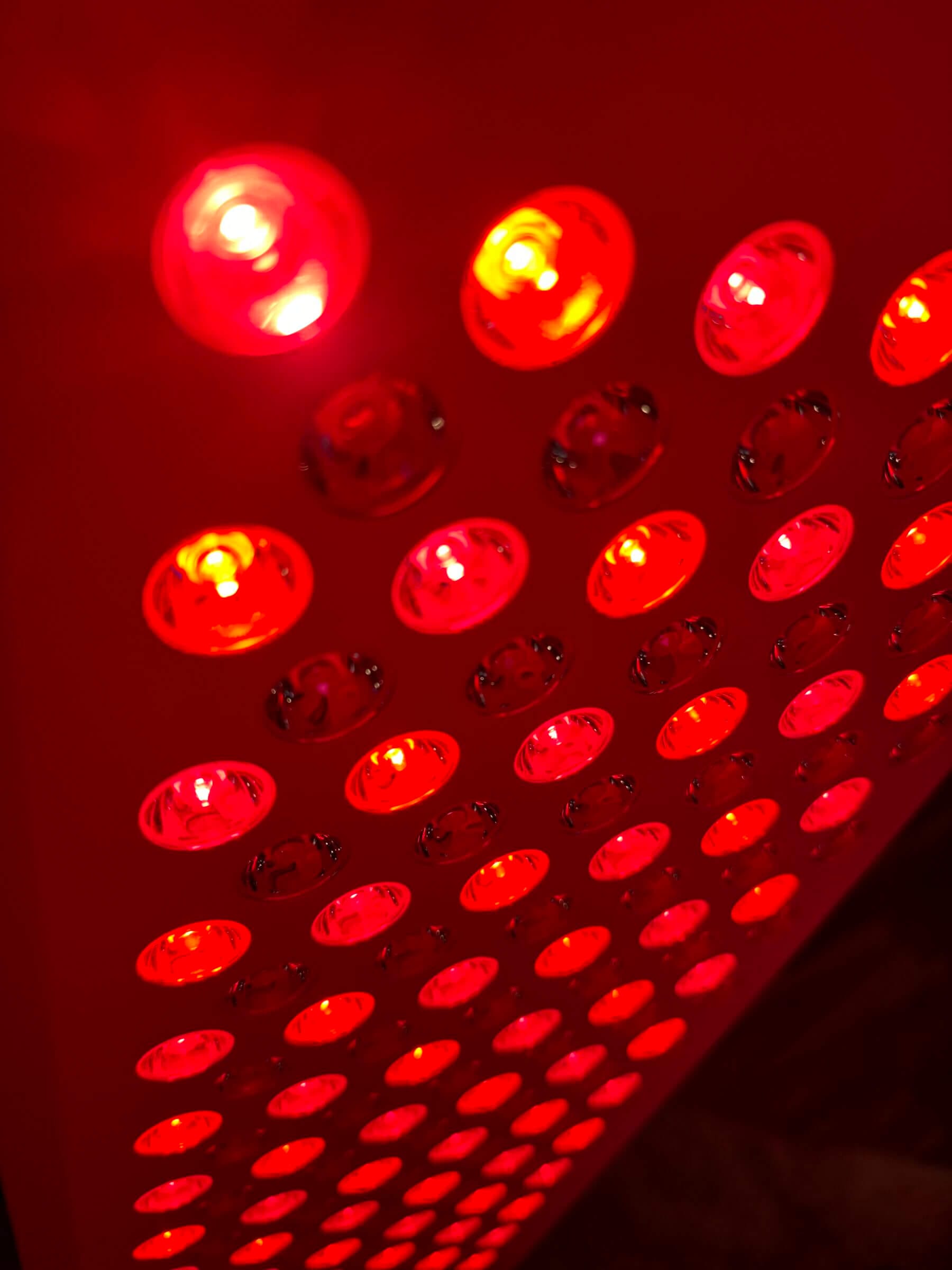
If you stumbled across this article while researching the best red light therapy devices for your budget, you can use the comparison table below to get an idea of how Mito Red Light compares to the competition.
| Features | Mito Red Light | Joovv | TrueLight |
|---|---|---|---|
| Flexible mounting options | ☑️ | ☑️ | ✘ |
| Portable panels | ☑️ | ☑️ | ☑️ |
| Modular panels | ☑️ | ☑️ | ✘ |
| Supported wavelengths | 630 nm, 660 nm, 830 nm, 850 nm | 660 nm, 850 nm | 580 nm, 630 nm, 660 nm, 850 nm |
| Irradiance | 115 – 170 mW/cm2 | 100 mW/cm2 | N/A |
| Beam angle | 60° | N/A | 60° |
| Warranty | 1-3 years | 1-2 years | 1 year |
| Mobile app support | Limited | ☑️ | ✘ |
| Return period | 60 days | 30-60 days | N/A |
| Pricing | $199 – $1,399 | $599 – $1,599 | $389 – $989 |
So let’s briefly talk about some of the key differences between Mito Red Light, Joovv and Truelight.
Mito Red Light vs. Joovv
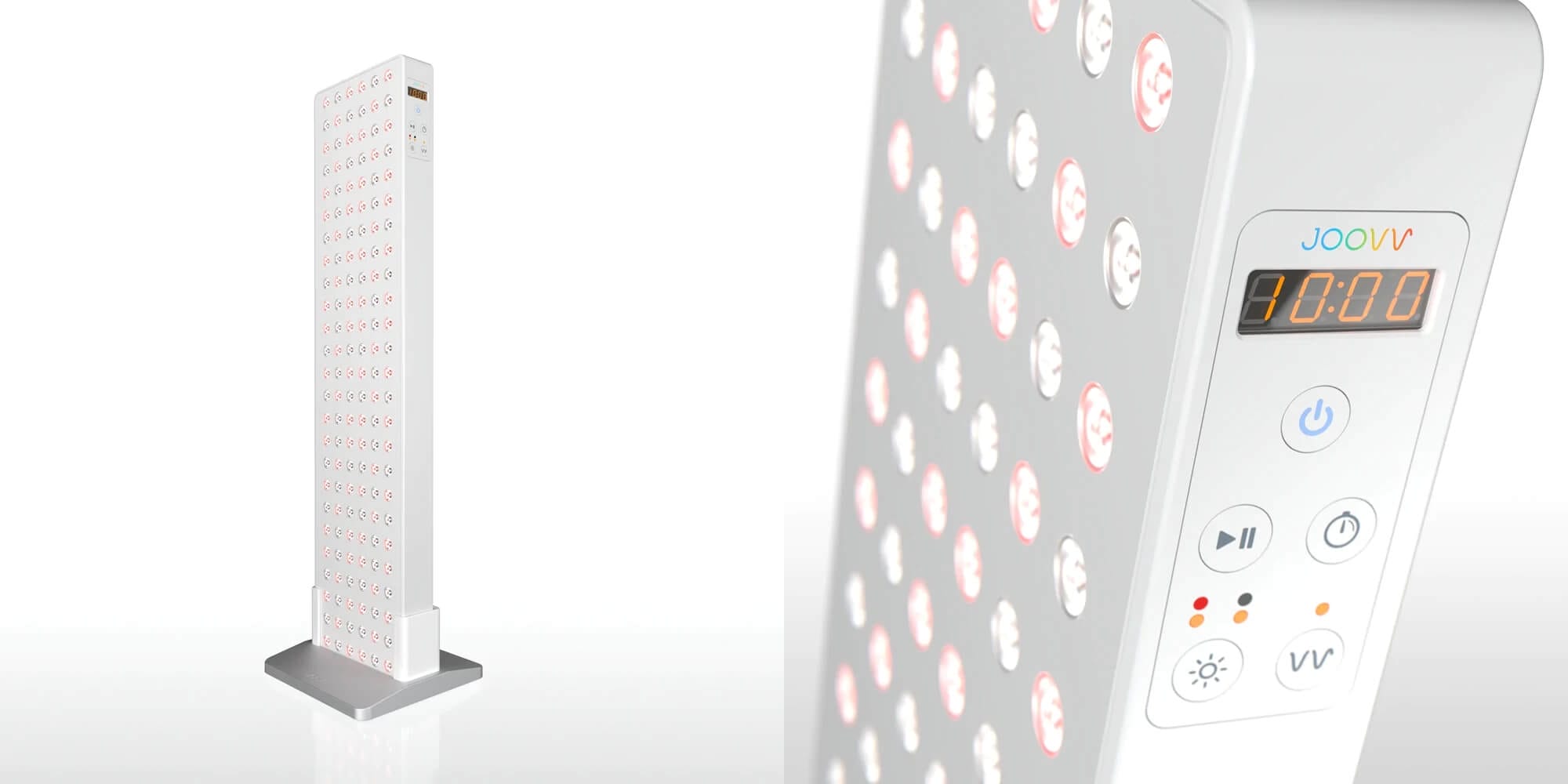
Joovv is known for producing premium red light therapy panels. However, in comparison to Mito Red Light, Joovv’s panels are more expensive with less powerful light modules. For example, in contrast to Mito, none of the Joovv panels support all four of the most bioactive wavelengths.
Additionally, the irradiance is lower across the board, which means that Joovv’s panels deliver less energy to the treatment area.
Combined with supporting only two of the four commonly used wavelengths, that makes Joovv’s panels slightly less effective.
Joovv also offers fewer mounting options than Mito Red Light, and their warranty is capped at two years instead of the three years Mito Red Light offers for its top-tier products.
However, one area where Joovv shines is its mobile app, which enables you to control any of its panels. Mito Red Light only offers a mobile app for its most expensive MitoADAPT series.
To learn more about Joovv and its various red light therapy panels, check out this comparison page.
Mito Red Light vs. TrueLight
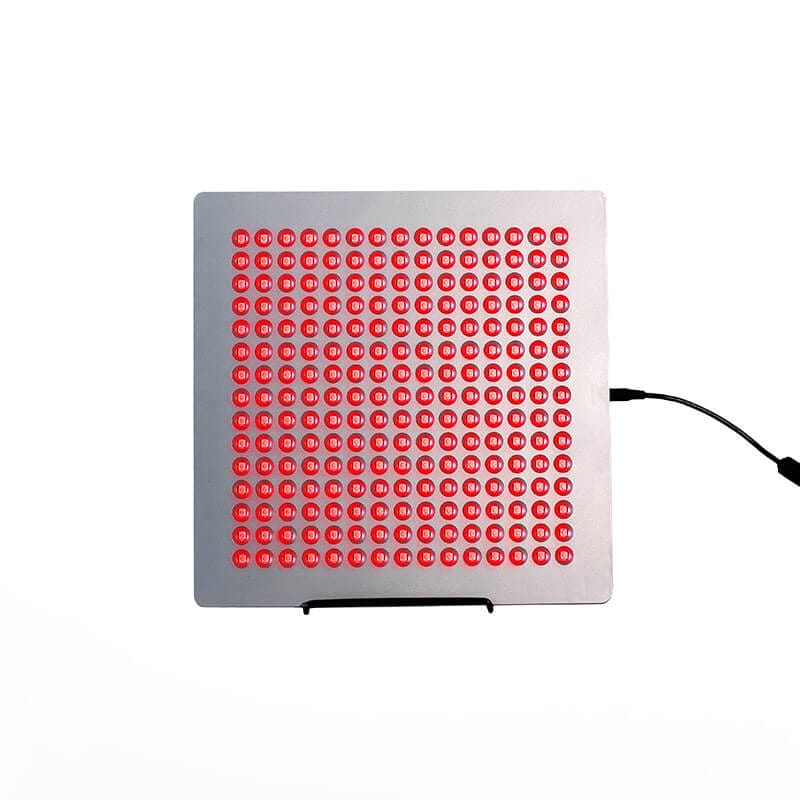
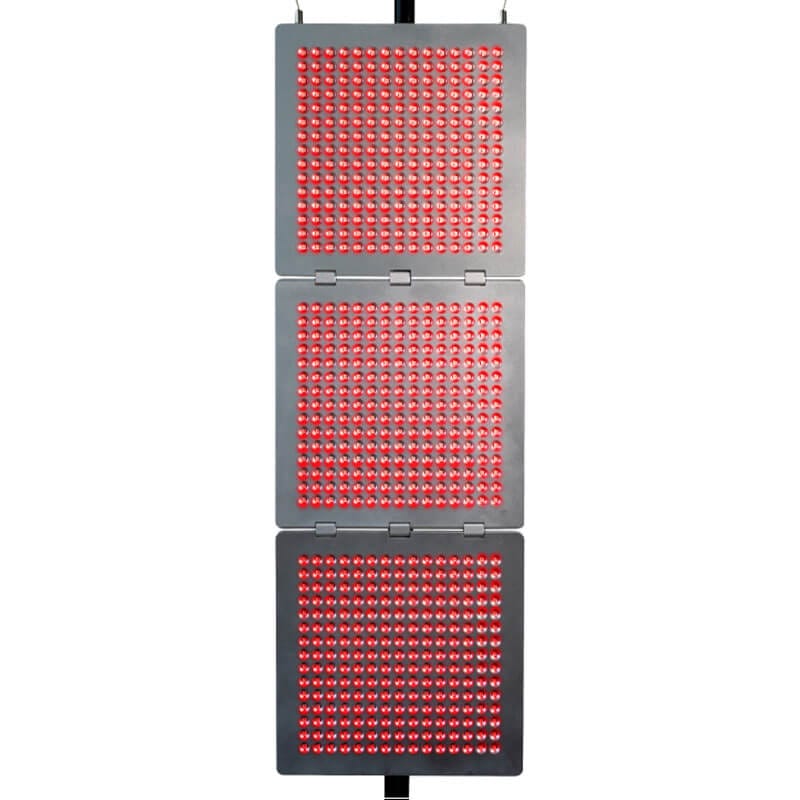
I learned about TrueLight while attending a 2022 biohacking conference in Los Angeles. The company offers only two panels: the smaller TrueLigt Energy Square 2.4 and the TrueLight Energy Trism (which includes three of the smaller panels stacked together).
What I like about TrueLight’s panels is that they emit yellow light in the 580 nm frequency, which is supposed to help boost lymphatic flow and remove waste from the skin. On the flip side, the TrueLight panels don’t cover the 630 nm wavelength, so you might lose some benefits in the area of antiaging and increased collagen production.
One thing I’ve noticed with the TrueLight panels is that they seem much less well-built than the ones from Mito Red Light and Joovv. Additionally, we own a TrueLight flashlight/nightlight combo that also emits red light, and it was defective when we took it out of its box. The replacement TrueLight sent stopped working after a short while as well, so I’m not incredibly confident in the build quality of TrueLight products.
The main reason why I might consider TrueLight is because even the largest panel is relatively portable due to its light weight. Plus, it folds down into a small square that can fit in a backpack or suitcase. While not as portable as the Mito Mobile or Joovv’s The Go 2.0, TrueLight may be your best bet if you want to treat your full body while on the go.
Mito Red Light FAQs
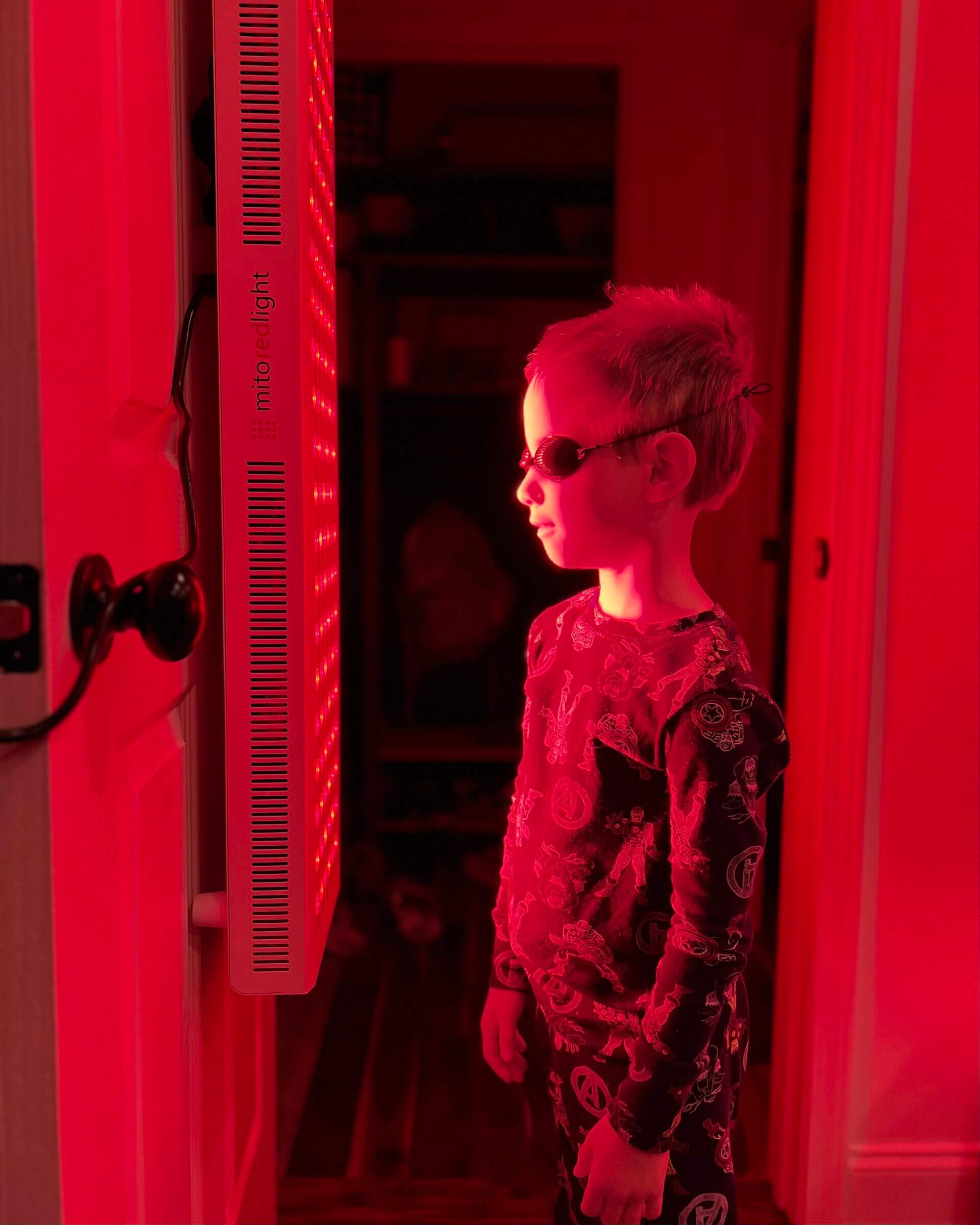
Mito Red Light devices are FDA Class II registered. They don’t require FDA clearance or approval due to their low-risk nature.
Depending on the size of your body, you’ll likely need at least two large and two small panels to cover the front and back of your body.
Each panel comes with a pulley system that makes it easy to mount the panel on a wall or door, while allowing you to raise or lower it (depending on the area of your body you’d like to treat).
While I encourage you to talk to your vet before treating your pet, red light therapy has been used to treat joint pain, back pain, and to help heal wounds in dogs, cats, horses and other animals. Check out my article about the benefits of red light therapy to learn more.
All Mito Red Light products come with a 60-day trial period. So you can return any product within 60 days for a full refund and without paying a restocking fee. However, you should note that in the event you decide to return the product to Mito Red Light within 60 days, you’re responsible for paying the return shipping fees. So just make sure you keep the original packaging to prevent the product from getting damaged during shipping.
Depending on the product, you’ll get a one-year, two-year or three-year warranty. Generally, the portable products come with a one-year warranty, whereas the red light panels come with a two-year or three-year warranty.
Unfortunately, Mito Red Light doesn’t sell its product on Amazon.
Mito Red Light Review: Final Verdict
Red light therapy has been on my radar for quite some time, and I’m glad I finally got my hands on a high-quality panel.
Mito Red Light offers quality products at a reasonable price. Some of the key features that set the higher-end red light panels apart from the competition are the supported wavelengths and the high irradiance. Combined, these two factors ensure that you’re getting enough light energy onto your skin and into the target tissue to deliver benefits.
My experience with the MitoPRO 1500 panel has been excellent, and I’m looking forward to adding additional panels, and maybe even a smaller desk unit to treat additional areas of my body and to further improve my overall health.
Are you using red light therapy as part of your wellness or skincare routine? Let me know by leaving a comment below! And if you’re not sure you have the space for a panel, check out my list of the top red light therapy devices to learn about smaller/more portable options.

Michael Kummer is a healthy living enthusiast and CrossFit athlete whose goal is to help people achieve optimal health by bridging the gap between ancestral living and the demands of modern society.
Medical Disclaimer
The information shared on this blog is for educational purposes only, is not a substitute for the advice of medical doctors or registered dieticians (which we are not) and should not be used to prevent, diagnose, or treat any condition. Consult with a physician before starting a fitness regimen, adding supplements to your diet, or making other changes that may affect your medications, treatment plan or overall health. MichaelKummer.com and its owner MK Media Group, LLC are not liable for how you use and implement the information shared here, which is based on the opinions of the authors formed after engaging in personal use and research. We recommend products, services, or programs and are sometimes compensated for doing so as affiliates. Please read our Terms and Conditions for further information, including our privacy policy.


Hi Michael! I just bought the MitoAdapt series. Do you know if adjusting the brightness affect the treatment?
I would suspect that lower brightness levels results in reduced effectiveness considering the light is less strong at lower settings.
hi, wich are the differences between Mito Mobile FLEX and kineon? tks
Hey Tiago!
Kineon Move+ is meant to treat injuries in joints and soft tissue and to support the regrowth of cartilage tissue. Red light panels, such as the Mito Mobile FLEX are best skin issues, collagen production and exercise recovery.
Cheers,
Michael
HM okay, and how you use the mito? daily? front and black? tks
Yeah, I use Mito on a regular basis (not every day but several times a week) on all sides of my body.
Sun Home Saunas Infrared Sauna Blanket does the same than mito? tks
No, those a different products with a different use case. The blanket is meant to transfer heat into your body and increase blood flow using far-infrared technology. Mito uses red and near-infrared light to help with skin health, increase collagen production, improve blood flow and more. However, Mito covers a much smaller area than the blanket.
Hello! Great review! Very informative and helpful! Can you please explain the concept of irradiance and its significance between the Mito Adapt and the Mito 300. I am trying to decide between the two devices. I noticed the irradiance is lower for the Mito adapt. How does this affect the treatment? Is it better to have wavelength flexibility or more irradiance coverage? Thank you!!
Hey Elle,
That depends a bit on your use case and what wavelengths you think you’ll use most. For example, if you want to use the panel mostly for cosmetic reasons, it might make sense to go with the MitoAdapt so you can dial in those frequencies. For a general purpose panel, I’d go with the Pro.